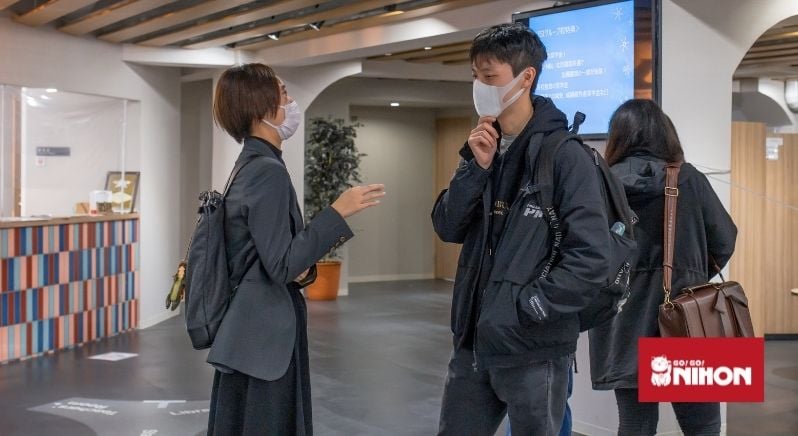In the summer of 2012, I followed behind my supervisor as she walked me around to each department in city hall, allowing me to introduce myself as the city’s new assistant language teacher. I spoke no Japanese at the time and memorized my entire self-introduction phonetically in the hopes that it would get me by until I had more time to study Japanese.
I remember sweating in my suit, bowing as much as possible, and hoping I wasn’t making too much of a fool of myself… And it worked! I survived!—And after five years here, I’d like to help as much as possible so you don’t have to worry as much as I did when I first came here.
A self-introduction (自己紹介, jikoshōkai, jiko meaning oneself and shoukai meaning introduction) sounds pretty self-explanatory in theory, but culturally in Japan, there are certain procedures to follow. It’s more of a “thing” here as opposed to the English “Hi, my name is…” When coming to Japan to study, work, or take the first steps into diving deeper into the culture, a quality Japanese self-introduction is indispensable.
The Jikoshōkai
As with culture and language in general, even when communication is nearly impossible (which is guaranteed to happen when traveling!), manners go a long way. Nobody will expect a foreign exchange student or tourist to step off the plane and speak perfect Japanese, but reading the situation, bowing, and smiling, will already set a good precedence.
Start with a hello (こんにちは, konnichiwa) if it’s during the day, a good evening (こんばんは, konbanwa) if it’s later into the day, or a “nice to meet you” (はじめまして, hajimemashite). Hajimemashite really means something along the lines of “it’s my first time meeting you,” but it’s best catch-all phrase when introducing yourself. If in doubt, just go with this one.
Follow with your name: “________________ to iimasu (と言います, my name is ________________). If you’d like people to call you by a nickname, you can say, “________________ to yonde kudasai (と呼んでください, please call me ________________). Tell everyone your nationality by saying for example, “Canada jin desu (カナダ人です, I’m Canadian), and where you’re from by saying, “Kariforunia kara kimashita (カリフォルニアから来ました, I’m from California). By the way, if you take this too literally and tell everyone you’re a Canadian from California, you’re gonna be a big liar on your first day.
These are the basics! Remember these and you’re off to a good start.

Etiquette
Subtlety is an important aspect of Japanese culture. It’s in all the little interactions, the art, the physical gestures, and the language itself. Missing them in the self-introduction, especially if you’ve just arrived in Japan, probably won’t be counted against you, but knowing the little details can give you some bonus points!
In Japanese culture, last names are stated before first names, so remember that in your “________________ to iimasu.” In English, usually people give a small explanation of their job or the name of their profession, but in Japan it can simply be “kaishain desu (会社員です, I’m an office worker” or “gakusei desu (学生です, I’m a student).” It’s nice to give one or two hobbies with “shumi wa ________________desu (趣味は________________です, my hobby is)” or strengths with “________________ wa tokui desu (________________は得意です, my strength is),” but remember, it’s important to be humble here. People want to know your strengths and what you enjoy, but too much of it will come off as bragging and make you seem overconfident.
Though we shake hands in the west, it’s usually reserved for those of the same or lower status over in Japan. If this person is your boss, your teacher, or somebody you don’t know, then play it safe and bow.—And don’t talk or finish up your speech while you’re bowing. Finish everything you say, and then bow. It’s considered rude to bow while talking.
Keep these little things in mind and make a strong first impression. If anything, it never hurts to be nice.
Make it your own
Of course (and as a warning, this is just from my experience, so take it with a pinch of salt), don’t feel the need to stick to this rigid template. Unless you’re interviewing for a big job at a serious company—in which case I imagine you’ll be required to speak pretty fluent Japanese, and probably won’t be needing this guide—remember that you’re there just as much to share your culture and who you are as you’re learning from those around you.
People will be curious and ask questions. Talk about your town, what your plans are for Japan or the future, or even show a special talent you may have up your sleeve. I’ve met friends who came here and sang a song or showed a cool trick when introducing themselves to a class of Japanese kids. Your situation may differ, but remember the basics, mind the etiquette, and have fun with it!
If you want to navigate this situation with ease, the best way is to study in a Japanese language school; it’s one of the first things you will learn, and the more you learn Japanese, the better your introduction will become!













